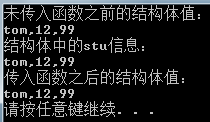一、结构体定义
结构体属于用户自定义的类型,允许用户存储不同的数据类型。
语法:struct 结构体名{结构体成员列表};
通过结构体创建变量有三种方式:
- struct 结构体名 变量名
- struct 结构体名 变量名={成员1值,成员2值...}
- 定义结构体时顺便创建变量
一般使用前两种,因为第三种在定义时创建的变量容易被人所忽略。
#include <iostream> using namespace std; struct Student { string name; int age; float score; }s3; int main() { //创建的时候struct关键字可以省略 struct Student s1; s1.name = "tom"; s1.age = 12; s1.score = 99; cout << "name:" << s1.name << "age:" << s1.age << "score:" << s1.score << endl; struct Student s2 ={"jack", 15, 98}; s3.name = "bob"; s3.age = 19; s3.score = 97; system("pause"); return 0; }
二、结构体数组
作用:将自定义的结构体放入到数组中方便维护。
语法:struct 结构体名 数组名[元素个数] = {{},{},...{}}
#include <iostream> using namespace std; struct Student { string name; int age; float score; }; int main() { //结构体数组定义 struct Student stuArr[3] { { "tom", 19, 99}, { "jack",15, 98}, { "bob", 22, 97 }, }; //可以修改值或者在这里进行赋值 stuArr[2].name = "mike"; //获取数组的长度 int length = sizeof(stuArr) / sizeof(stuArr[0]); //遍历数组 for (int i = 0; i < length; i++) { cout << stuArr[i].name << stuArr[i].age << stuArr[i].score << endl; } system("pause"); return 0; }
三、结构体指针
作用:通过指针来访问结构体中的成员
#include <iostream> using namespace std; struct Student { string name; int age; float score; }; int main() { struct Student s = { "tom",12,99 }; Student* p = &s; //需要使用->来访问 cout << p->name << p->age << p->score << endl; system("pause"); return 0; }
四、结构体嵌套结构体
#include <iostream> using namespace std; struct Student { string name; int age; float score; }; struct Teacher { int id; string name; int age; Student stu; }; int main() { struct Teacher t; t.id = 1; t.name = "joke"; t.age = 45; struct Student stu = { "tom",12,99 }; t.stu = stu; cout << t.id << t.name << t.age << t.stu.name << t.stu.age << t.stu.score << endl; system("pause"); return 0; }
五。结构体做函数参数
作用:将结构体作为参数向函数传递。
传递方式有两种:值传递、引用传递。
值传递:
#include <iostream> using namespace std; struct Student { string name; int age; float score; }; //值传递 void printStudent(Student stu) { stu.name = "jack"; stu.age = 22; stu.score = 90; cout << "结构体中的stu信息:" << endl; cout << stu.name << "," << stu.age << "," << stu.score << endl; } int main() { struct Student stu = { "tom",12,99 }; cout << "未传入函数之前的结构体值:" << endl; cout << stu.name << "," << stu.age << "," << stu.score << endl; printStudent(stu); cout << "传入函数之后的结构体值:" << endl; cout << stu.name << "," << stu.age << "," << stu.score<< endl; system("pause"); return 0; }
输出:
引用传递:
#include <iostream> using namespace std; struct Student { string name; int age; float score; }; //值传递 void printStudent(Student* stu) { stu->name = "jack"; stu->age = 22; stu->score = 90; cout << "结构体中的stu信息:" << endl; cout << stu->name << "," << stu->age << "," << stu->score << endl; } int main() { struct Student stu = { "tom",12,99 }; struct Student* p = &stu; cout << "未传入函数之前的结构体值:" << endl; cout << stu.name << "," << stu.age << "," << stu.score << endl; printStudent(p); cout << "传入函数之后的结构体值:" << endl; cout << stu.name << "," << stu.age << "," << stu.score << endl; system("pause"); return 0; }
输出:
六、结构体中const的使用场景
作用:用const防止误操作
#include <iostream> using namespace std; struct Student { string name; int age; float score; }; //值传递 void printStudent(const Student* stu) { /*这里就不能进行修改了 stu->name = "jack"; stu->age = 22; stu->score = 90; */ cout << "结构体中的stu信息:" << endl; cout << stu->name << "," << stu->age << "," << stu->score << endl; } int main() { struct Student stu = { "tom",12,99 }; struct Student* p = &stu; cout << "未传入函数之前的结构体值:" << endl; cout << stu.name << "," << stu.age << "," << stu.score << endl; printStudent(p); cout << "传入函数之后的结构体值:" << endl; cout << stu.name << "," << stu.age << "," << stu.score << endl; system("pause"); return 0; }
输出:
只需要记住,用const修饰的数据类型就不能再进行更改。